The defenders of the Zagórz railway junction in 1918
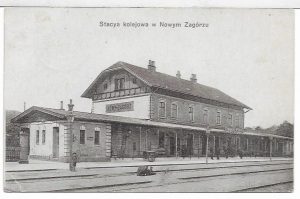
The history of these heroes of the fight for the independence of Poland reborn after the partitions – unfortunately, most of them do not know their names – began at the end of October 1918. At that time, numerous detachments of demobilised soldiers from the Austro-Hungarian army and Russian prisoners of war found themselves in the area of the Zagórz railway junction. In order to prevent excesses on the part of the military, whose morale had been greatly strained by the chaos engulfing the partitioning empires, the railwaymen of Zagórz took matters into their own hands. „(…) With the knowledge and permission of the head of the Zagórz railway station at the time, Mr. Rolicki, we formed a guard patrol, whose task was to garrison railway facilities and protect property that was to be the property of the Polish state. (…)” – This is an excerpt from the memoirs of BronisławDziedzicki. He was one of the participants in a successful operation to take control of the railway infrastructure located within Zagórz. In very scarce historical sources concerning this event, apart from BronisławDziedzicki, the following people were mentioned: Ludwik Marko, Leon Sikorski, Milasz (first name unknown), Edward Lichy and four other volunteers unknown by name. As early as November 3, 1918, the railway guard was reinforced with a company of the 3rd Battalion of the Sanok Riflemen. As the Polish-Ukrainian armed conflict over the nationality of eastern Galicia escalated, the Zagórz railway junction gained in strategic importance with each passing day.
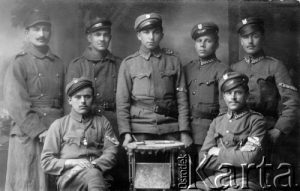
The local community’s response to the numerous challenges posed by the Ukrainian military offensive was to establish the Committee for the Defence of the Zagórz Junction. This body, created on the initiative of Dr Jan Puzdrowski, included: Andrzej Batruch, Leon Jasłowski, Jan Maślanik, Aleksander Stroiński, WładysławOzgaj and Zygmunt Grzebień. The increasingly difficult situation on the Polish-Ukrainian front required the involvement of extraordinary forces and resources. Polish armoured trains set out to the relief of Lwów and Przemyśl, defended by teenage defenders who went on to become known as the Lviv and Przemyśl Eaglets. There were several of them, but in the context of the military operations conducted within the Zagórz railway junction, the trains named „Kozak” and „Gromobój” are most frequently mentioned. The circumstances of their construction and the detailed course of their service are the subject of frequently contradictory inquiries and interpretations by a narrow circle of professional historians and railway enthusiasts. This does not change the fact that the above-mentioned armoured trains played a key role in the rebuilding of Polish statehood in what is now known as eastern Galicia.
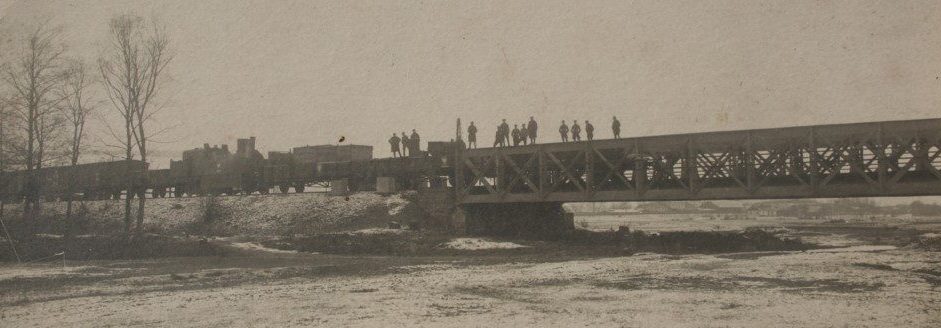
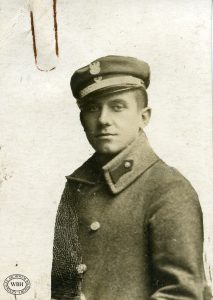
a patrol on the railway bridge on
the Osława River. Photo From the
collection of Grzegorz Nycz
An example of the dedication and bravery of the crews of the armoured trains, operating on the railway tracks converging in Zagórz, is the tragic story of a member of the crew of the armoured train „Kozak”, Second Lieutenant StanisławSasKorczyński. In 1917, as a graduate of the Sanok gymnasium, he was drafted into the Austrian army. After graduating from a one-year military school in Vienna, the newly-graduated artilleryman was sent to the Italian front, from where he returned to Sanok at the beginning of November 1918, after the fall of Austria-Hungary as an ensign. Here he reported to the local command of the reborn Polish Army. After being assigned to the newly created Podkarpacie Group, Ensign StanisławSasKorczyński as a gunner of the armoured train „Kozak” on November 23, 1918 set off to the region of Chyrów which was besieged by Ukrainian troops. On the first day of 1919 the rail gunner was promoted to the rank of second lieutenant. Unfortunately, the same month he died in circumstances that were described by his mother Amalia SasKorczyńska in a letter to the military authorities preserved in the Central Military Archives: „(…) on January 19, 1919 during an intelligence excursion organized by the „Kozak” armoured train, he died on the railway track near Chyrów, hit by a grenade (…), by his own cannon, together with his servicemen, i.e. CHMURA serving for one year and ŚLĄSKI. All were buried in the Central Cemetery in Sanok. They were among the many now sadly mostly nameless Polish patriots who, by giving their lives for the reborn Homeland, created the legend of the 1918 Defenders of the Zagórz Railway Junction. With a view to commemorating their heroic deeds, commemorative Crosses of the Defenders of the Zagórz Junction were awarded from 7 November 1920.
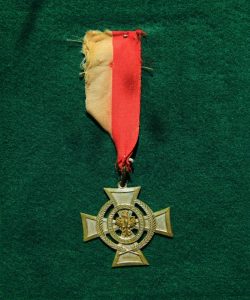
Photo From the collection of the
Military Historical Bureau (Central
Military Archives)
With a view to commemorating their heroic deeds, commemorative Crosses of the Defenders of the Zagórz Junction were awarded from 7 November 1920. These badges were made of bronze in the Zagórz steam locomotive depot. Their reverses were marked with consecutive numbers. One of the original crosses from that period was placed as a votive gift in the parish church of the Assumption of the Blessed Virgin Mary in Zagórz. This unique decoration and the name of one of the Zagórz streets were until recently the only elements in the Zagórz public space reminding of the local heroes of the independence uprising of 1918. The memory of the Defenders of the Zagórz Railway Junction of 1918 is cultivated with particular care and commitment by the local association called DolinaKolejowa.pl.
